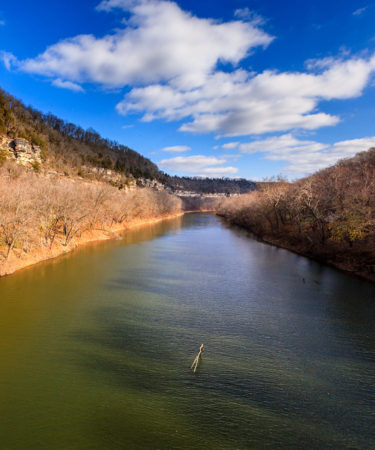Legally speaking, bourbon can be made anywhere in the U.S. But we’re not gonna talk about that. We want to know why 95% of national bourbon production takes place in one region in northwestern Kentucky. Not trying to invite the wrath of bourbonites (Kentucky-bound and beyond), but what the hell makes the place so special?
For some spirits, like vodka, where the spirit is distilled doesn’t really have an impact on the final outcome or flavor. Even the concept of “terroir” or flavor from ingredients used to make vodka (pretty much anything short of an old shoe, which is a glorious thing about vodka) doesn’t really apply, since the vodka production process basically involves stripping all the flavoring congeners from the base product. Compare that to Scotch, where mash bill recipes can vary—and flavors/congeners are maintained during distillation, so those variations show through. Other factors—like where the Scotch is made (the coastline adds salinity, e.g.), whether the barley is peated, etc.—will also influence the final flavor.
And the same is true for bourbon. But it’s not just about variations in the mash bill (which is always 51% corn, minimum). Bourbon, or we should say Kentucky bourbon, attributes a lot of its liquid greatness to the local climate.
First incredibly important factor: limestone water, one of Kentucky’s proudest and staunchest claims of differentiation. What makes it so special? For one, it filters out undesirable elements like iron (which can turn the mash dark and just give the final product a pretty rough flavor) and adds good minerals like calcium. It also has higher pH than other water, which aids in fermentation.
And then it’s also just been a part of bourbon production since the beginning. As University of Kentucky geology professor Alan Fryar told Louisville’s NPR station, “the emergence of bourbon-making in this part of the country” has everything to do with the fact that “limestone water was what we had in the late 1700s.” Of course it should be noted that some bourbon distilleries don’t (or simply can’t) use limestone water, due to sourcing and quantity issues.
Second incredibly important factor: climate. Kentucky bourbon is stored in rackhouses (or rickhouses), basically specially-built warehouses with dirt floors, tin roofs, and many stories stacked with bourbon. Traditionally rickhouses aren’t temperature controlled, meaning the hot Kentucky summers and cool winters become essential in pulling the whiskey both into and contracted it out of the charred oak barrel (that transition, from into and out of the wood, is responsible for a lot of bourbon’s complexity).
There’s even concern that climate change—yielding hotter summers, for one—could dramatically impact bourbon production. (In warmer countries, like Jamaica, it takes far less time for rum to mature; colder climates like Scotland tend to require longer maturation periods as there’s less warmth to encourage interaction with the barrel.) But the rickhouses are built specifically to mitigate (and take advantage of) the region’s current climate fluctuations: summer heat drawn in with tin roofing, humidity levels maintained with a dirt floor.
Third incredibly important factor: the wood itself, legally required to be charred new American oak. This has a bit less to do with Kentucky terroir since that particular species can be grown in around half the country (though it, too, may be threatened by climate change).
Since not everyone in Kentucky agrees on every aspect of bourbon production—and variety is the spice of life, anyway—it’d probably be an uphill battle to convince them that bourbon could be made with careful monitoring and manipulations elsewhere (by artificial imitation of that Kentucky climate). But if 95% of the world’s bourbon comes from one region in one state, there’s gotta be something to it, right?
